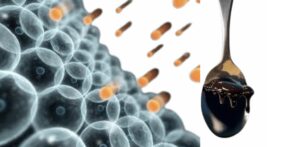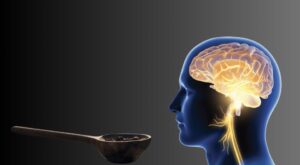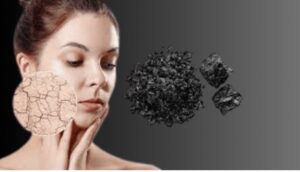In the quest for eternal youth and vitality, humans have explored countless avenues, from skincare regimen to dietary supplements. One such natural substance that has gained significant attention in recent years for its anti-aging properties is Shilajit.
Originating from the Himalayan mountains, Shilajit is a potent mineral resin known for its rejuvenating effects and health-promoting qualities.
Let’s delve deeper into what makes Shilajit a promising contender in the realm of anti-aging.
Key Anti-Aging Benefits of Shilajit
1. Powerful Antioxidant Activity

One of the primary reasons for aging is oxidative stress, which occurs due to an imbalance between free radicals and antioxidants in the body. Free radicals are unstable molecules that can damage cells and contribute to aging and disease. Shilajit is a potent antioxidant that helps neutralize these free radicals, thereby reducing oxidative damage and slowing down the aging process.
Understanding Oxidative Stress and Aging
Oxidative stress occurs when there’s an imbalance between free radicals and antioxidants in the body. Free radicals are generated as a natural byproduct of metabolic processes, but they can also be produced in response to environmental factors such as pollution, UV radiation, and unhealthy lifestyle choices like smoking and poor diet. When left unchecked, free radicals attack cellular structures such as proteins, lipids, and DNA, causing cellular damage and contributing to aging and disease progression.
Shilajit’s Antioxidant Arsenal
Shilajit owes its antioxidant prowess to its rich composition of bioactive components, including fulvic acid, humic acid, dibenzo-alpha-pyrones, and various minerals such as selenium, zinc, and copper. These compounds work synergistically to scavenge free radicals and inhibit oxidative stress, thereby protecting cells from damage and promoting longevity.
Scientific Evidence Supporting Shilajit’s Anti-Aging Effects
Numerous studies have investigated the antioxidant properties of Shilajit and its impact on aging-related processes:
|
Practical Considerations and Usage
To harness the antioxidant benefits of Shilajit, it is commonly consumed in a purified resin or powder form. The recommended dosage varies depending on factors such as age, health status, and specific health goals. It can be taken orally by mixing with water, milk, or herbal teas. Due to its strong taste and smell, some individuals prefer encapsulated supplements.
2. Cellular Energy Production

Shilajit enhances mitochondrial function, which are the powerhouse of cells responsible for producing energy (ATP). As we age, mitochondrial function declines, leading to decreased energy levels and cellular degeneration. By supporting mitochondrial health, Shilajit helps maintain energy production and overall cellular function, which are crucial for youthful vitality.
Shilajit, a natural resin with origins in the Himalayan mountains, has garnered attention for its ability to support mitochondrial health and enhance cellular energy production.
The Role of Mitochondria in Energy Production
Mitochondria play a crucial role in cellular metabolism by converting nutrients from food into ATP through a process known as oxidative phosphorylation. This ATP fuels various cellular functions, including muscle contraction, nerve impulses, and biochemical reactions essential for life.
Shilajit’s Impact on Mitochondrial Function
Shilajit contains bioactive compounds such as fulvic acid, dibenzo-alpha-pyrones, and trace minerals like Coenzyme Q10, which are known to support mitochondrial function in several ways:
- Enhanced ATP Production: Research suggests that Shilajit helps optimize mitochondrial ATP synthesis by facilitating electron transport chain activity and improving mitochondrial respiration. This results in increased cellular energy levels, which can enhance physical performance and reduce fatigue.
- Antioxidant Protection: Mitochondria are vulnerable to oxidative damage due to their role in energy metabolism. Shilajit’s antioxidant properties help protect mitochondria from oxidative stress, thereby preserving their function and integrity.
- Regulation of Mitochondrial Biogenesis: Shilajit has been shown to stimulate mitochondrial biogenesis – the process by which new mitochondria are formed within cells. This is crucial for maintaining mitochondrial density and function, especially in tissues with high energy demands such as muscles and brain.
Scientific Evidence Supporting Shilajit’s Benefits
| Several studies have investigated the effects of Shilajit on mitochondrial function and energy metabolism:
A study published in the Journal of Ethnopharmacology demonstrated that Shilajit supplementation increased ATP levels in skeletal muscle cells, enhancing physical performance and recovery. Research published in the Journal of Alzheimer’s Disease indicated that Shilajit extract improved mitochondrial function in neuronal cells, potentially offering neuroprotective benefits against age-related cognitive decline. |
Practical Application and Dosage
Shilajit is typically consumed orally in purified resin or powdered form. The dosage can vary depending on factors such as age, health status, and desired outcomes. It is often mixed with water, milk, or herbal teas for easier consumption due to its strong taste and odor.
3. Supports Cognitive Function

Cognitive decline is a common aspect of aging, characterized by memory loss, reduced focus, and slower mental processing. Shilajit has been shown to support cognitive function by protecting brain cells from oxidative damage, reducing inflammation in the brain, and promoting the production of key neurotransmitters.
These actions contribute to improved memory, mental clarity, and overall brain health.
Mechanisms of Cognitive Support by Shilajit
Shilajit exerts its beneficial effects on cognitive function through several mechanisms:
- Antioxidant Protection: Oxidative stress is implicated in cognitive decline and neurodegenerative diseases. Shilajit’s antioxidant properties help neutralize free radicals, reducing oxidative damage to brain cells and preserving cognitive function.
- Neurotransmitter Modulation: Shilajit influences neurotransmitter levels in the brain, including dopamine, serotonin, and acetylcholine. These neurotransmitters play critical roles in memory formation, mood regulation, and cognitive performance.
- Anti-inflammatory Effects: Chronic inflammation in the brain is linked to cognitive impairment. Shilajit has anti-inflammatory properties that can help mitigate neuroinflammation, supporting overall brain health.
Scientific Evidence Supporting Shilajit’s Cognitive Benefits
| Numerous studies have explored the effects of Shilajit on cognitive function:
Research published in the journal Alzheimer’s & Dementia demonstrated that Shilajit extract improved cognitive performance in Alzheimer’s disease models by reducing amyloid-beta aggregation and enhancing synaptic plasticity. A study in healthy volunteers found that Shilajit supplementation enhanced cognitive parameters such as attention, memory, and mental processing speed, suggesting potential benefits for maintaining cognitive function in aging adults. |
Practical Application and Usage
Shilajit is typically consumed orally in resin or powdered form. The dosage can vary depending on individual needs and health goals. It is often mixed with water, milk, or blended into smoothies for easier consumption. Due to its strong taste, some prefer encapsulated supplements.
Integrating Shilajit into Your Cognitive Health Routine
Whether you’re looking to maintain cognitive function as you age or enhance mental clarity and focus, Shilajit offers a natural and scientifically-backed approach. By supporting antioxidant defenses, neurotransmitter balance, and reducing neuroinflammation, Shilajit nourishes the brain and promotes optimal cognitive performance.
4. Joint and Bone Health

As we age, joint stiffness, reduced bone density, and increased susceptibility to fractures become more prevalent.
Shilajit contains minerals like calcium, magnesium, and potassium, which are essential for maintaining bone density and joint flexibility. Additionally, its anti-inflammatory properties help alleviate joint pain and improve mobility, thus supporting musculoskeletal health in older adults.
Key Benefits of Shilajit for Joint and Bone Health
- Mineral Support: Shilajit contains essential minerals such as calcium, magnesium, potassium, and zinc, which are vital for maintaining bone density and strength. These minerals play a crucial role in bone mineralization and overall skeletal health.
- Anti-inflammatory Properties: Chronic inflammation can contribute to joint pain and stiffness. Shilajit exhibits anti-inflammatory effects, helping to reduce inflammation in joints and alleviate discomfort associated with conditions like arthritis.
- Cartilage Protection: Shilajit has been shown to protect cartilage from degradation by inhibiting enzymes that break down cartilage tissue. This preservation of cartilage integrity supports joint flexibility and range of motion.
- Collagen Support: Collagen is a protein that provides structure to bones, joints, and connective tissues. Shilajit promotes collagen synthesis, contributing to the maintenance of healthy joints and resilient bones.
Scientific Evidence Supporting Shilajit’s Effects on Joint and Bone Health
| A study published in the Journal of Medicinal Food highlighted Shilajit’s ability to reduce markers of inflammation and oxidative stress in joint tissues, suggesting potential benefits for managing arthritis and other inflammatory joint conditions.
Research has demonstrated that Shilajit supplementation can enhance bone mineral density and improve bone strength in animal models, indicating its potential as a natural approach to osteoporosis prevention and management. |
Practical Application and Usage
Shilajit is commonly consumed orally in resin or powdered form. The dosage may vary based on individual needs and health status. It can be mixed with water, milk, or blended into smoothies for easier consumption. Some individuals prefer encapsulated supplements to mask its strong taste.
Integrating Shilajit into Your Joint and Bone Health Routine
Whether you are looking to maintain joint flexibility, manage joint discomfort, or support bone density, Shilajit offers a natural and holistic approach. By providing essential minerals, reducing inflammation, protecting cartilage, and promoting collagen synthesis, Shilajit helps fortify your musculoskeletal system for enhanced mobility and vitality.
5. Enhances Skin Health

The appearance of skin is a visible indicator of aging. Shilajit supports skin health by improving blood circulation, boosting collagen production, and providing essential minerals that nourish the skin. Regular use of Shilajit can help reduce the appearance of fine lines and wrinkles, improve skin elasticity, and promote a youthful glow.
Key Benefits of Shilajit for Skin Health
- Antioxidant Protection: Shilajit is a potent antioxidant that helps neutralize free radicals, which contribute to skin aging by damaging collagen and elastin fibers. By reducing oxidative stress, Shilajit supports skin cell regeneration and helps maintain a youthful appearance.
- Collagen Synthesis: Collagen is essential for skin structure and elasticity. Shilajit promotes collagen synthesis, helping to improve skin firmness and reduce the appearance of wrinkles and fine lines.
- Anti-inflammatory Properties: Chronic inflammation can exacerbate skin conditions such as acne, eczema, and psoriasis. Shilajit’s anti-inflammatory effects help calm inflamed skin, reduce redness, and promote healing.
- Nutrient Delivery: Shilajit contains minerals like zinc, copper, iron, and magnesium, along with vitamins and amino acids that nourish the skin. These nutrients support cellular function and contribute to a healthy complexion.
Scientific Evidence Supporting Shilajit’s Effects on Skin
| Research published in the Journal of Cosmetic Dermatology demonstrated that topical application of Shilajit extract reduced skin roughness and improved skin texture and hydration levels.
Studies have shown that Shilajit enhances wound healing by promoting cell migration and collagen deposition, indicating its potential in supporting skin repair and regeneration. |
Practical Application and Usage
Shilajit can be used topically as well as orally to benefit skin health:
- Topical Use: Mix Shilajit powder with water, aloe vera gel, or a carrier oil (such as coconut oil or jojoba oil) to create a facial mask or serum. Apply to clean skin and leave on for 15-20 minutes before rinsing off. This method allows direct absorption of Shilajit’s nutrients into the skin.
- Oral Consumption: When taken orally, Shilajit supports skin health from within by providing essential nutrients and antioxidants that nourish skin cells and promote overall skin vitality.
Integrating Shilajit into Your Skincare Routine
Whether you are looking to reduce signs of aging, improve skin texture, or manage skin conditions, Shilajit offers a natural and effective solution. Its multifaceted benefits, from antioxidant protection to collagen support and anti-inflammatory properties, make it a valuable addition to any skincare regimen.
How to Incorporate Shilajit into Your Routine
Shilajit is typically available in resin or powder form and can be consumed orally. It has a strong taste and smell, so it is often mixed with water, milk, or herbal teas for easier consumption. The dosage varies depending on the individual’s age, health status, and specific health goals. It is advisable to consult with a healthcare provider before starting any new supplement regimen.
Conclusion
In conclusion, Shilajit stands out as a natural remedy with promising anti-aging benefits, backed by centuries of traditional use and supported by modern scientific research. Its antioxidant properties, ability to support mitochondrial function, and diverse mineral content make it a valuable addition to anti-aging strategies. Whether you are looking to enhance your cognitive function, maintain youthful skin, or support overall vitality as you age, Shilajit offers a holistic approach to aging gracefully.
Embrace the ancient wisdom of Shilajit and unlock the potential of this remarkable substance in your journey towards a healthier, more youthful life.

